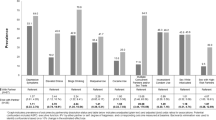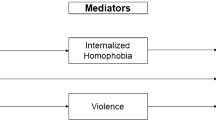Abstract
After release from incarceration, former female inmates face considerable stressors, which may influence drug use and other risk behaviors that increase risk for HIV infection. Involvement in a committed partnership may protect women against re-entry stressors that may lead to risky behaviors. This study measured the association between time since release from incarceration (1–6 months ago, and >6 months ago versus never incarcerated) and HIV risk behaviors and evaluated whether these associations differed by involvement in a committed partnership. Women released within the past 6 months were significantly more likely to have smoked crack cocaine, used injection drugs and engaged in transactional sex in the past month compared to never-incarcerated women and women released more distally. Stratified analyses indicated that incarceration within the past 6 months was associated with crack cocaine smoking, injection drug use and transactional sex among women without a committed partner yet unassociated with these risk behaviors among those with a committed partner.
Similar content being viewed by others
References
Chen NE, Meyer JP, Springer SA. Advances in the prevention of heterosexual transmission of HIV/AIDS among women in the United States. Infect Dis Rep. 2011;3(1):e6:20–9.
Greenfeld L, Snell T (2000) Bureau of Justice Statistics Special Report: women Offenders. U.S. Department of Justice, Bureau of Justice Statistics, Washington.
Snyder HN (2012) Arrest in the United States, 1990–2012, US Department of Justice, Bureau of Justice Statistics, Washington.
Hoffman JA, Klein H, Eber M, Crosby H. Frequency and intensity of crack use as predictors of women’s involvement in HIV-related sexual risk behaviors. Drug Alcohol Depend. 2000;58(3):227–36.
Mathers BM, Degenhardt L, Phillips B, et al. Global epidemiology of injecting drug use and HIV among people who inject drugs: a systematic review. Lancet. 2008;372(9651):1733–45.
Strathdee SA, Stockman JK. Epidemiology of HIV among injecting and non-injecting drug users: current trends and implications for interventions. Curr HIV/AIDS Rep. 2010;7(2):99–106.
Weller SC D-BK (2002). Condom effectiveness in reducing heterosexual HIV transmission: Cochrane Database Syst Rev.
Spaulding A, Stephenson B, Macalino G, Ruby W, Clarke JG, Flanigan TP. Human immunodeficiency virus in correctional facilities: a review. Clin Infect Dis. 2002;35(3):305–12.
Mallik-Kane KVC. Health and prisoner reentry: how physical, mental, and substance abuse conditions shape the process of reintegration. Washington: The Urban Institute; 2008.
D.C. AfaSD (2008). Move along: policing sex work in Washington, D.C.: A report by the Alliance for a Safe & Diverse D.C, Different avenues, Washington.
Binswanger IA, Stern MF, Deyo RA, et al. Release from prison—a high risk of death for former inmates. New Engl J Med. 2007;356(2):157–65.
Farrell M, Marsden J. Acute risk of drug-related death among newly released prisoners in England and Wales. Addiction. 2008;103(2):251–5.
Singer MI, Bussey J, Song LY, Lunghofer L. The psychosocial issues of women serving time in jail. Soc Work. 1995;40(1):103–13.
Covington S (2002). A woman’s journey home: challenges for female offenders and their children. From Prison to Home Conference, Bethesda.
Harlow CW (2003) Education and correctional populations: US Department of Justice, Bureau of Justice Statistics.
Harp KL, Oser C, Leukefeld C. Social support and crack/cocaine use among incarcerated mothers and nonmothers. Subst Use Misuse. 2012;47(6):686–94.
Belle D. Gender differences in the social moderators of stress. In: Barnett RC, Biener L, Baruch GK, editors. Gender and Stress. New York: Free Press; 1987. p. 257–77.
Covington S, Surrey J. The relational model of women’s psychological development: implications for substance abuse. In: Wilsnack S, Wilsnack R, editors. Gender and alcohol: individual and social perspectives. New Brunswick: Rutgers University Press; 1997. p. 335–51.
Miller JB. Toward a new psychology of women. Boston: Beacon Press; 1976.
Finkelstein N. Using the relational model as a context for treating pregnant and parenting chemically dependent women. In: Underhill B, Finnegan D, editors. Chemical dependency: women at risk. New York: Harrington Park Press; 1996. p. 23–44.
Alarid LF, Burton VS, Cullen FT. Gender and crime among felony offenders: assessing the generality of social control and differential association theories. J Res Crime Delinq. 2000;37(2):171–99.
Griffin ML, Armstrong GS. The effect of local life circumstances on female probationers’ offending. Justice Q. 2003;20(2):213–39.
El-Bassel N, Gilbert L, Rajah V, Foleno A, Frye V. Fear and violence: raising the HIV stakes. AIDS Educ Prev. 2000;12(2):154–70.
Seal DW, Eldrige GD, Kacanek D, Binson D, MacGowan RJ. A longitudinal, qualitative analysis of the context of substance use and sexual behavior among 18 to 29-year-old men after their release from prison. Soc Sci Med. 2007;65(11):2394–406.
Western B. The impact of incarceration on wage mobility and inequality. Am Sociol Rev. 2002;67(4):526–46.
Fu JJ, Herme M, Wickersham JA, et al. Understanding the revolving door: individual and structural-level predictors of recidivism among individuals with HIV leaving jail. AIDS Behav. 2013;17(Suppl 2):S145–55.
Davis KC, Masters NT, Eakins D, et al. Alcohol intoxication and condom use self-efficacy effects on women’s condom use intentions. Addict Behav. 2014;39(1):153–8.
Weafer J, Fillmore MT. Comparison of alcohol impairment of behavioral and attentional inhibition. Drug Alcohol Depend. 2012;126(1–2):176–82.
Division of HIV/AIDS Prevention, National Center for HIV/AIDS, Viral Hepatitis, Sexual Transmitted Diseases and Tuberculosis Prevention, Centers for Disease Control and Prevention (2013). HIV and substance use in the United States.
DeHovitz JA, Kelly P, Feldman J, Sierra MF, Clarke L, Bromberg J, et al. Sexually transmitted diseases, sexual behavior, and cocaine use in inner-city women. Am J Epidemiol. 1994;140(12):1125–34.
Lejuez CW, Bornovalova MA, Daughters SB, Curtin JJ. Differences in impulsivity and sexual risk behavior among inner-city crack/cocaine users and heroin users. Drug Alcohol Depend. 2005;77(2):169–75.
Baliunas D, Rehm J, Irving H, Shuper P. Alcohol consumption and risk of incident human immunodeficiency virus infection: a meta-analysis. Int J Public Health. 2010;55(3):159–66.
Stall R, McKusick L, Wiley J, Coates TJ, Ostrow DG. Alcohol and drug use during sexual activity and compliance with safe sex guidelines for AIDS: The AIDS Behavioral Research Project. Health Educ Behav. 1986;13(4):359–71.
Zablotska IB, Gray RH, Serwadda D, Nalugoda F, Kigozi G, Sewankambo N, Lutalo T, Mangen FW, Wawer M. Alcohol use before sex and HIV acquisition: a longitudinal study in Rakai, Uganda. AIDS. 2006;20(8):1191–6.
Younge SN, Salazar LF, Crosby RF, DiCLemente RJ, Wingood GM, Rose E. Condom use at last sex as a proxy for other measures of condom use: is it good enough? Adolescence. 2008;43(172):927–31.
Latimer WW, Moleko AG, Melnikov A, et al. Prevalence and correlates of hepatitis A among adult drug users: the significance of incarceration and race/ethnicity. Vaccine. 2007;25:7125–31.
Harrell PT, Mancha BE, Petras H, Trenz RC, Latimer WW. Latent classes of heroin and cocaine users predict unique HIV/HCV risk factors. Drug Alcohol Depend. 2012;22(1):220–7.
Epperson MW, Khan MR, Miller DP, Perron BE, El-Bassel N, Gilbert L. Assessing criminal justice involvement as an indicator of human immunodeficiency virus risk among women in methadone treatment. J Subst Abuse Treat. 2010;38(4):75–83.
Senn TE, Carey MP, Vanable PA, Coury-Doniger P, Urban M. Sexual partner concurrency among STI clinic patients with a steady partner: correlates and associations with condom use. Sex Transm Infect. 2009;85(5):343–7.
van Empelen P, Schaalma HP, Kok G, Jansen MW. Predicting condom use with casual and steady sex partners among drug users. Health Educ Res. 2001;16(3):293–305.
National Institute of Alcohol Abuse and Alcoholism. NIAAA council approves definition of binge drinking. NIAAA Newslett. 2004;3:3.
Khan MR, Wohl DA, Weir SS, Adimora AA, Moseley C, Norcott K, et al. Incarceration and risky sexual partnerships in a southern US city. J Urban Health. 2008;85(1):100–13.
Morrow KM, Project START. Study Group. HIV, STD, and hepatitis risk behaviors of young men before and after incarceration. AIDS Care. 2009;21(2):235–43.
Vlahov D, Putnam S. From corrections to communities as an HIV priority. J Urban Health. 2006;83(3):339–48.
Wilson ME, Kinlock TW, Gordon MS, O’Grady KE, Schwartz RP. Postprison release HIV-risk behaviors in a randomized trial of methadone treatment for prisoners. Am J Addict. 2012;21(5):476–87.
Freudenberg N. Jails, prisons, and the health of urban populations: a review of the impact of the correctional system on community health. J Urban Health. 2001;78(2):214–35.
Graham N, Wish ED. Drug-use among female arrestees: onset, patterns, and relationships to prostitution. J Drug Issues. 1994;24(1–2):315–30.
McLean R, Robarge J, Sherman S. Release from jail: moment of crisis or window of opportunity for female detainees? J Urban Health. 2006;83(3):382–93.
Richie BE. Challenges incarcerated women face as they return to their communities: findings from life history interviews. Crime Delinq. 2001;47(3):368–89.
German D, Latkin CA. Social stability and HIV risk behavior: evaluating the role of accumulated vulnerability. AIDS Behav. 2012;16(1):168–78.
Murphy LS (2007) Determinants of behavior in women choosing to engage in street-level prostitution. Policy Brief, Issue Brief No. 6, University of Maryland Baltimore County, Baltimore.
El-Bassel N, Gilbert L. Correlates of crack abuse among drug-using incarcerated women: psychological trauma, social support, and coping behavior. Am J Drug Alcohol Abuse. 1996;22(1):41–56.
Glaze LE, Maruschak LM (2008) Parents in prison and their minor children (Publication No NCJ 222984), U.S. Department of Justice, Bureau of Justice Statistics, Washington.
Farley M, Kelly V. Prostitution: a critical review of the medical and social sciences literature. Women Crim Justice. 2000;11(4):29–64.
Logan TK, Leukefeld C. Sexual and drug use behaviors among female crack users: a multi-site sample. Drug Alcohol Depend. 2000;58(3):237–45.
Bryant J, Brener L, Hull P, Treloar C. Needle sharing in regular sexual relationships: an examination of serodiscordance, drug using practices, and the gendered character of injecting. Drug Alcohol Depend. 2010;107(2–3):182–7.
Lescano CM, Vazquez EA, Brown LK, Litvin EB, Pugatch D, Project SSG. Condom use with “casual” and “main” partners: what’s in a name? J Adolesc Health. 2006;39(3):443e1–7.
Singer MI, Bussey J, Song LY, Lunghofer L. The psychosocial issues of women serving time in jail. Soc Work. 1995;40(1):103–13.
Staton-Tindall M, Duvall JL, Leukefeld C, Oser CB. Health, mental health, substance use, and service utilization among rural and urban incarcerated women. Womens Health Issues. 2007;17(4):183–92.
Calhoun S, Messina N, Cartier J, Torres S. Implementing gender-responsive treatment for women in prison: client and staff perspectives. Fed Probat. 2010;74(3):27–33.
Leukefeld C, Havens J, Tindall MS, Oser CB, Mooney J, Hall MT, et al. Risky relationships: targeting HIV prevention for women offenders. AIDS Educ Prev. 2012;24(4):339–49.
Tucker MB. Social support and coping: applications for the study of female drug abuse. J Soc Issues. 1982;38(2):117–37.
Harp KL, Oser C, Leukefeld C. Social support and crack/cocaine use among incarcerated mothers and nonmothers. Subst Use Misuse. 2012;47(6):686–94.
Falkin GP, Strauss SM. Social supporters and drug use enablers: a dilemma for women in recovery. Addict Behav. 2003;28(1):141–55.
Staton-Tindall M, Frisman L, Lin HJ, et al. Relationship influence and health risk behavior among re-entering women offenders. Womens Health Issues. 2011;21(3):230–8.
El-Bassel N, Wechsberg WM, Shaw SA. Dual HIV risk and vulnerabilities among women who use or inject drugs: no single prevention strategy is the answer. Curr Opin HIV AIDS. 2012;7(4):326–31.
Freudenberg N, Daniels J, Crum M, Perkins T, Richie BE. Coming home from jail: the social and health consequences of community reentry for women, male adolescents, and their families and communities. Am J Public Health. 2005;95(10):1725–36.
Kuo I, Greenberg AE, Magnus M, Phillips G 2nd, Rawls A, Peterson J, et al. High prevalence of substance use among heterosexuals living in communities with high rates of AIDS and poverty in Washington, DC. Drug Alcohol Depend. 2011;117(2–3):139–44.
Staton-Tindall M, Leukefeld C, Palmer J, Oser C, Kaplan A, Krietemeyer J, et al. Relationships and HIV risk among incarcerated women. Prison J. 2007;87(1):143–65.
Teplin LA, Abram KM, McClelland GM. Prevalence of psychiatric disorders among incarcerated women. Arch Gen Psychiatry. 1996;53(6):505–12.
Acknowledgments
This research was funded by a grant awarded to William Latimer from the National Institute on Drug Abuse (NIDA-R01 DA14498). The funding source played no role in the study design; in the collection, analysis and interpretation of data; in the writing of the report; or in the decision to submit the paper for publication.
Author information
Authors and Affiliations
Corresponding author
Rights and permissions
About this article
Cite this article
Hearn, L.E., Whitehead, N.E., Khan, M.R. et al. Time Since Release from Incarceration and HIV Risk Behaviors Among Women: The Potential Protective Role of Committed Partners During Re-entry. AIDS Behav 19, 1070–1077 (2015). https://doi.org/10.1007/s10461-014-0886-9
Published:
Issue Date:
DOI: https://doi.org/10.1007/s10461-014-0886-9




